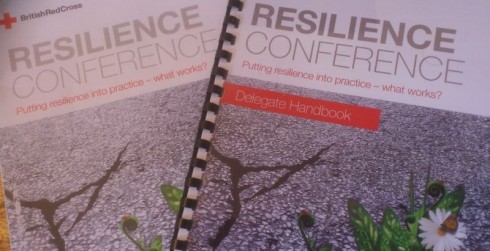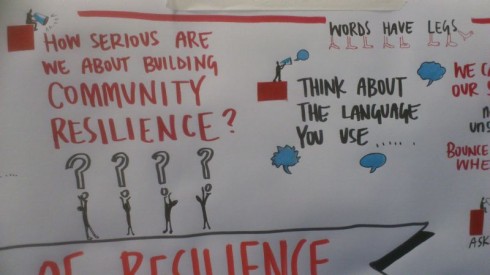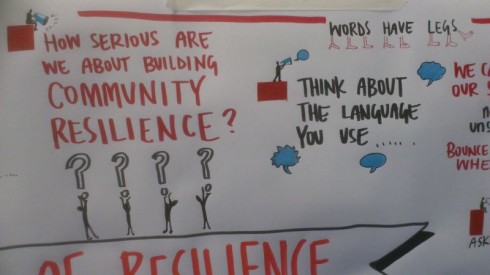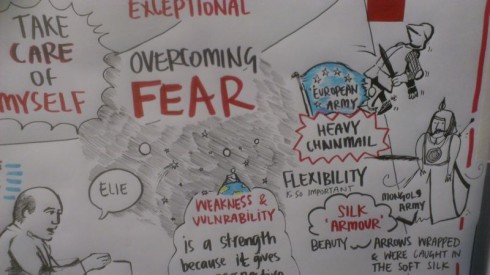17 Apr 2013
Six resilience “aha!” moments
Usually when I go to events I tend to be the ‘resilience guy’, or one of a handful of people who work with and think about resilience who tend to gather at the back of other events and bemoan the fact that no-one has talked about resilience yet. So I was fascinated when I saw that the British Red Cross was hosting a one-day conference on resilience, the first that I’ve been aware of. They had stated that the objectives of the day were to:
- share and generate learning on how resilience building works in practice in various settings and from a variety of perspectives – in other words, what works well and why?
- understand how humanitarian agencies can effectively contribute to building resilience within communities.
About 200 people attended, including researchers and policy-makers, community activists, people involved in refugee services,emergency/humanitarian response,health and social care and age-related resilience. It was a fascinating day, and one that I’d like to share five of my lightbulb moments from the day.
Even in spite of getting the early early train from Totnes (a real test of my own personal resilience), I still arrived after it had been going for about 20 minutes already. I arrived as Ian Whitehouse from the Civil Contingencies Secretariat was speaking about how the UK government approaches resilience. A couple of things he said stuck with me. The first was that he saw part of his work as being to “make resilience relevant”, and how important partnership was in that.
But then he talked about how he wanted to “enable the public to receive key communications resilience messages”, which, given the theme that ran through the day of a key aspect of resilience being about learning and the ability to innovate and learn, felt alarmingly top-down. He also talked about how resilience needed to be looked at “in the world of increasingly scarce resources”, where it was clear that what he meant by building resilience to scarce resources (i.e. funding) and what Transition means (fossil fuels) were somewhat divergent (you can read attendee Julian Dobson’s blog on this session here).
I did later catch up with Ian during the coffee break and ask him about this, and he said that energy shortages are factored into their thinking, but my impression was only in the sense of a sudden disruption to supply, not the ongoing economic impacts of ongoing high and volatile prices, and their impact on community resilience.
There was then a panel discussion looking at ‘Ingredients of Resilience’. This was Lightbulb Moment 1, getting a strong sense of how very differently the term resilience is used by people from a range of backgrounds. I knew it already, but this panel discussion really reinforced, as the Chair later put it, “the wide range of stuff being funnelled into one word”. From my notes it is hard to attribute what was said to who said it, so I will list a few of the key points that came out of the session:
- It is vital that we think about widening inequality when we talk about resilience. The National Risk Register doesn’t even feature inequality, whereas the World Economic Forum’s Global Risk Report shows it as the third greatest risk
- Community-led action is a great generator of resilience
- Resilience has a ‘desirability deficiency’, as in it needs to be able to be presented as something desirable
- In very difficult times (the speaker had lived in Bosnia during the war there) taking care of yourself is key to resilience. Resilience also comes from having friends and neighbours who give you the agency to survive, and having something that makes you get out of bed every day to do something about it
- The secret ingredient of resilience is asking “why not?”
- Is resilience really about bouncing back, and if so to what? Young people who have experienced trauma can end up very armoured, fundamentally altered by the experience
- One of the speakers very confidently announced that we are “halfway through a Great Depression”, which I thought showed either remarkable clairvoyance or remarkable optimism!
- One comment was that resilience needed to become a more political idea and needed to explicitly speak up for poverty
- The Big Society as an idea failed because it didn’t address issues of poverty and inequality. It assumed that you can have a society without asking why there are pockets of inequality and disadvantage. The people hurt most by the absence of community resilience are those who have least
One member of the audience who commented was an academic from Northern Ireland who had done research into the Troubles there. She challenged the very concept of resilience. “If you cut us we bleed” she said, arguing that wounds are very real and do exist. She said it was important to look at the history of words, the politics of words, what burdens they brings and what, and whose, political purposes they serve, who suffers the most and why, and “resilience” really needs to be explored in that context. Her point was that if all people have known is hardship and trauma, what is it that they are supposed to “bounce back” to? Where exactly is that resilience going to come from? It was a fascinating opening session, giving a great insight into the wide range of views on resilience, on what it means to different people and different disciplines.
After a break I went to a workshop by Sarah Longlands of University of Glasgow called “Growing resilient local communities”. Her research looked at how the concept of resilience could be understood in the context of local places, in relation to the PhD work she is currently doing. She looked at how resilience is about how people work together, as well as the commercial economy of a place and the public and social economies.
What was especially interesting was how she was looking at the overlap between resilience and economic growth, an issue that has been explored here at Transition Culture on a few occasions in the past. This was Lightbulb Moment 2, that there are actually other people also looking at the overlap between these two issues, and further exploring the debate that has been often had here before at Transition Culture about the degree to which community resilience and economic growth as we know it are incompatible.
She described how government thinking is that we can create resilient places by encouraging economic growth, but is that actually the case? Everyone assumes that growth will bring everything we want in its wake: jobs, income, wealth and welfare provision. She used the term “growth privileging” to describe how growth as a concept tends to take priority over most other concepts when the future of communities is discussed.
Her work looked at two very different settlements and their relationship to the idea of growth. Her talk led to a very interesting conversation, and concluded with her saying that she felt that resilience will come from small organisations on the ground with the courage to challenge how things are being done. It will be interesting to see the outcomes of her work when it is complete.
The second workshop I went to (there were loads of fascinating choices) was run by Gayle Whelan of Liverpool John Moores University. She talked about how she had been part of a project to map the community assets of the Wirral on Merseyside. An asset was defined as being “any resource, skill or knowledge which enhances the ability of individuals, families and neighbours to sustain their health and wellbeing”. They looked at a wide range of initiatives, 54 in total, and in what ways they contribute to community resilience.
Their findings were that these groups/organisations/projects empower individuals and have a positive impact on individuals and their communities. Lightbulb Moment 3 was how community resilience is often, as Gayle put it, “driven by committed people”, rather than needing some kind of ‘mass conversion’ before anything meaningful can start to take place. That behind each of the projects on her asset map were a small number of passionate, driven people who made it happen. One of her closing thoughts was “you can throw money at things but if you don’t have people with passion and commitment you can’t do anything”, a fascinating counterpoint to Ian Whitehouse’s more top-down approach earlier. It reminded me of this passage from Andrew Zolli and Ann Marie Healy’s excellent recent book ‘Resilience‘:
“When we found a resilient community or organisation, we almost always found a very particular species of leader at or near its core. Whether old of young, male or female, these translational leaders play a critical role, frequently behind the scenes, connecting constituencies, and weaving various networks, perspectives, knowledge systems, and agendas into a coherent whole. In the process, these leaders promote adaptive governance – the ability of a constellation of formal institutions and informal networks to collaborate in response to a crisis”.
The ‘graveyard shift’, the slot straight after lunch was fantastic, a great way to stave off the droopy eyelids. Members of the cast performed songs and scenes from the musical ‘The Glasgow Girls’, currently being performed by the National Theatre of Scotland. It tells the story of how young asylum seekers in Glasgow came together to try and stop the Immigration Department from doing dawn raids to deport people, including families with small children. It was a powerful story of the power of the human spirit and of personal and community resilience. Very moving too. Lightbulb Moment 4 was that sessions first thing after lunch can be high energy, moving and inspiring. No-one nodded off.
In the next session, I co-presented a workshop with Jenna Collins of the New Local Government Network and Ann Griffiths of the London Borough of Ealing. I spoke about Transition and how it approaches resilience. They talked about work they had done on ‘dependency’ and on how the Council could reduce levels of dependency while at the same time building resilience and improving quality of life.
Although at first glance there wasn’t a lot of overlap between both presentations, it soon led into a very interesting discussion about the balance between communities coming together and self-organising to make things happen, a la Transition, and governments, local and national, using the cloak of Austerity to divest themselves of their responsibilities. This was Lightbulb Moment 5, reinforcing the importance of this discussion. Should communities fill holes and services left by budget cuts, or does doing so somehow legitimise and lessen the impact of those cuts? There was a sense that this was a real tension at the heart of the community resilience debate, and increasingly so as Austerity continues to bite.
It echoed something I had read in a recent interview with Noam Chomsky, where he had said, in a discussion about how Occupy had stepped in to help communities following Hurricane Sandy:
“The wealthy and the corporate sector are delighted to have government back off, because then they get more power. Suppose you were to develop a voluntary system, a community type, a mutual support system that takes care of social security – the wealthy sectors would be delighted”.
I have to say that I don’t really agree with him, but that’s a subject for a different post. It’s a fascinating discussion though, whether a community stepping in to fill in gaps left by austerity cuts is actually, in the bigger picture, undermining its own resilience, and the need to think it through in more detail was certainly a lightbulb moment for me.
Also discussed was the relationship between resilience and social enterprise and the more traditional economy. In my talk I had mentioned the NE Seattle Tool Library, and was asked whether there was already a tool hire business in the area, and if so, was such a project a good idea, and whether it actually contributed to the resilience of the area. I mentioned examples such as Bristol, where the engagement with Transition and other groups had led to the Council’s Peak Oil Report for the city which had led to the ‘Who Feeds Bristol’ report looking at food resilience, which had led to Bristol Pound, a process of building trust and relationships.
The final closing session included a go-round for comments. One person said “now I believe in community!”, although then added that she wasn’t exactly sure where to find it. Another stated that for him the key thing is how we cultivate the ability to learn. Someone stated that an emphasis on resilience could lead to blame “why didn’t you cope, why didn’t you bounce back?”, putting the onus on victims to sort themselves out. One of my favourite comments was from the person who said that they now felt “confused at a higher level”. What the role of the public sector is in terms resilience was also discussed.
My final Lightbulb Moment from the day was when someone from the British Red Cross had spoken about research that showed how the majority of people turning up at Accident and Emergency units who could have had some basic first aid treatment before coming in to the hospital hadn’t had it, and about separate research that showed that people with first aid training had more self-confidence and were more likely to get back into work. They were starting to see that delivering first aid training in disadvantaged communities would be a great way of building resilience across the board. The step of applying that thinking to a wider range of the aspects of community resilience, as Transition does, has yet to arise as an option, but it felt like bringing so many people from different spheres of the resilience debate, can only have been a good thing in terms of deepening thinking.
So, a day well spent, some useful ideas and thinking, although I couldn’t help thinking that that rare opportunity to spend a day in the same room as 200 resilience practitioners but to only meet a couple of them was a missed opportunity. Some kind of ‘speed dating event’ at the beginning would have been good to enable more cross-pollenation. Thanks to the British Red Cross for organising the day.
Images above are from the rather fine graphic facilitation that went on during the event. A great way to document the points and debates emerging from an event like this. You can follow people’s tweets from the day @resilienceconf.



